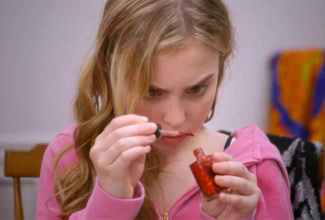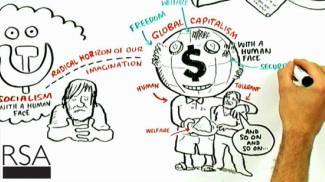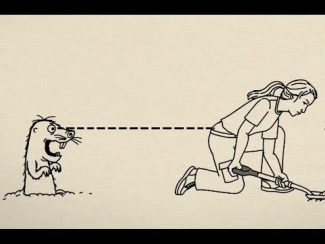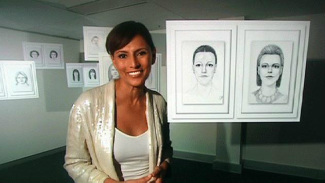 Katie fakes her period and receives a "first moon" party. Katie fakes her period and receives a "first moon" party. Tags: bodies, children/youth, commodification, consumption/consumerism, gender, health/medicine, marketing/brands, sex/sexuality, commercial, humor, menstruation, 00 to 05 mins Year: 2014 Length: 2:20 Access: YouTube Summary: The company HelloFlo has distinguished itself with its innovative marketing of feminine hygiene products, as well as a lively blog and the informative “Ask Dr. Flo” column. This advertisement portrays an adolescent girl who is impatient for the arrival of her first period. At the start, we see her decorating a clean pad with red nail polish. Her mother discovers the pad and pretends that she has been duped. The mother then concocts an extravagant revenge plot in the form of a “First Moon Party,” even though she knows the daughter has yet to have a period. While the advertisement enlists humor to defuse discomfort and embarrassment, the resulting comedy treats male and female characters inequitably and relies upon familiar tropes of conniving girls and devious women. For example, the mother deceives her daughter and exposes her to unwanted attention from men and boys. Grown men do imbecilic things and inspire eye-rolling, while the girl, the supposed protagonist, does something adolescent—after all, she is an adolescent—and suffers punishment. While in the past, a girl might have been daunted by the secrecy and shame surrounding menstruation, here she is discomfited by a denial of privacy, as others take over her rite of passage (one she herself has yet to undergo). The narrative closure comes when the girl admits to her lie and asks whether she will be grounded. Her mother reveals that she has already punished her with the party and then gives her a “period starter kit” as a gift. The advertisement concludes by giving the punchline to a male partygoer who awaits the flow from a sluggish ketchup bottle; he advises another young girl, “Sometimes you just gotta wait.” The ad is framed as a parody, but given the delicate and gendered subject matter, questions arise. How and when can humor dismantle convention? Who is the protagonist? Toward whom is this spot directed? Who is relieved of embarrassment? And to what end? Note that The Sociological Cinema has previously explored how the topic of how menstruation gets handled by the media here and here. Submitted By: Rose Marie McSweeney
6 Comments
 Žižek argues charitable consumption prolongs capitalism's ills. Žižek argues charitable consumption prolongs capitalism's ills. Tags: capitalism, consumption/consumerism, corporations, culture, economic sociology, marketing/brands, marx/marxism, political economy, theory, charity, corporate social responsibility, cultural capitalism, morality, starbucks, žižek, 06 to 10 mins Year: 2010 Length: 10:56 Access: YouTube Summary: In this animated segment of a longer lecture, Slavoj Žižek critiques the cultural dimensions of contemporary capitalism. Žižek begins by stating how capitalism has changed from a dichotomy between production and traditional charity (e.g. Soros earns money by exploiting workers then gives it back to humanist causes), to a form of capitalism that brings the dimensions of morality and consumption together. He offers several examples of this "cultural capitalism," including Starbucks and Tom's Shoes. In each of these instances, the act of consumption and doing good are part of the same process, which has now been universalized throughout capitalism. It is meant to make people (i.e. consumers) feel good about themselves in that they are helping poor people or a degraded environment. However, Žižek argues that by participating in this system, consumers are actually "prolonging the disease ... rather than curing it." He promotes changing the structure rather than this sort of charitable act: "The proper aim is to try and reconstruct society on such a basis that poverty would be impossible and the altruistic virtues have really prevented the carrying out of this aim." He compares this system to slave owners who were kind to their slaves because they prevented oppressed slaves from realizing the core injustice of slavery; in other words, it suggests that we are doing enough to address the system's ills and prevents more significant change. While there is an implicit argument to do away with capitalism here, Žižek explicitly states that 20th century socialism was a "mega catastrophe" and does not promote a return to that system. The clip also works well to initiate critical discussions of corporate social responsibility, Fair Trade, and other social certifications, and begin to imagine what more radical alternatives might look like. Submitted By: Paul Dean  Women are often held responsible when others objectify them. Women are often held responsible when others objectify them. Tags: biology, bodies, gender, marketing/brands, sex/sexuality, biological determinism, dress negotiation, gender blame, sexism, sexual objectification, 00 to 05 mins Year: 2013 Length: 0:30 Access: YouTube Summary: This commercial from Duluth Trading Company is an accurate example of the ways in which women are subtlety encouraged to participate in forms of security from men’s seemingly-natural demeanor. Indeed, through the purchase and use of a Duluth Trading Company "Longtail" t-shirt, women are promised the security from the "gawking gopher," a character that stares as the fictional female character bends to perform a task. The blame, in this case, is placed on women for not covering up, perhaps framed as a feminine task to help men sooth their "inherent" tendencies to be hypersexual. From this born-this-way perspective, men avoid responsibility for their objectification of women. This means that, among other things, men are also excluded as solutions to such an issue. Instead of discouraging men to “gawk” through a deconstruction of the relationship between masculinity and objectification, this commercial delicately—yet notably—places the male response to a women’s body as a natural reaction that can only be solved through the further policing of women’s bodies. Submitted By: Peter Rydzewski  Segmenting the market by gender, companies increase profits. Segmenting the market by gender, companies increase profits. Tags: capitalism, children/youth, consumption/consumerism, gender, inequality, marketing/brands, gender roles, gender socialization, market economy, market segmentation, toys, 06 to 10 mins Year: 2014 Length: 7:24 Access: YouTube Summary: In this episode from the Australian television series The Checkout, gendered marketing is analyzed and, specifically, the theory of market segmentation is explored. This theory posits that dividing consumers up into smaller groups is good for business; as the video demonstrates, gender is a common criteria upon which companies segment the market and increase the sales of their products. Product elements such as "shape, texture, packaging, logos, verbiage, graphics, sounds, and names [are all used] to define the gender of a brand." For example, Lego company tripled the sales of the same product and boosted their annual global revenue by as much as 25% when they created Lego Friends for girls and building sets and action figures for boys. Similar to children’s toys, companies segment the market by gender when advertising products for adults as well. Among the many examples cited in the video, Dove Company created “For Men” soaps, which have more squared edges than its regular, ellipse-shaped soap bars, packed in grey boxes in order to give a more “macho mystique” to the product. This video can be used in classrooms for explaining the connections between capitalist market economy and gender socialization, and its implications for gender inequalities. The video highlights how gender inequality manifests in the different prices of these products, with "women's products" often costing much more than those marketed toward men. However, viewers can also consider other ways that gendered marketing contributes to gender inequality. For other examples and critiques of gendered marketing on The Sociological Cinema, click here, here, and here. For a collection of pics on gendered marketing, click here. Submitted By: Nihal Çelik  This ad reinforces viewers' belief in the American Dream. This ad reinforces viewers' belief in the American Dream. Tags: class, consumption/consumerism, marketing/brands, marx/marxism, nationalism, theory, american dream, commercial, ideology, 00 to 05 mins Year: 2014 Length: 0:30 Access: YouTube Summary: Ideologies are sets of ideas and beliefs through which people make sense of the social world. Ideologies are always related to power, with dominant ideologies reinforcing existing power relations. The American Dream is a particularly powerful ideology that reinforces class relations by perpetuating the belief that anyone who works hard can be economically sucessful (despite the overwhelming evidence of how class inequality shapes economic outcomes). This car commercial illustrates this ideology with a discussion of the excellence that has come out American garages: "The Wright brothers started in a garage, Amazon started in a garage, Hewlett Packard started in a garage ... the Ramones started in a garage. My point? You never know what kind of greatness can come out of an American garage." It suggests that anyone can do great things from humble beginnings, a fundamental element of the American Dream. The emphasis on "American" suggests that this idea is a uniquely American characteristic, even though upward mobility is more common in other developed countries. The ad goes on to show a Cadillac literally and metaphorically emerging from an American garage, thereby using notions of the American Dream to appeal to consumers' aspirations and nationalistic pride. It is not only an attempt to sell both Cadillac cars and attach those meanings to its brand, but also reinforces viewers' sense of the American Dream as reality. However, this association begs the question: Who does the American Dream apply to? In reality the American dream is not for the poor, but for the rich. Furthermore, it is not just the corporations that utilize the American Dream to market products to society; politicians and public figures often utilize images of the American society to convince people to support public policy, similar to how it is being used in this car commercial. For a scathing critique of the American dream, see this clip from George Carlin. Submitted By: Kelsey Gallaher  "The Scarecrow" explores the McDonaldization of society "The Scarecrow" explores the McDonaldization of society
Tags: capitalism, consumption/consumerism, corporations, environment, food/agriculture, marketing/brands, organizations/occupations/work, science/technology, theory, weber, farming, fordism, george ritzer, mcdonalidzation, rationalization, slow food, subtitles/CC, 00 to 05 mins
Year: 2013 Length: 3:23 Access: YouTube Summary: "The Scarecrow" is Chipotle's most recent commercial exploring the American dependency on highly rationalized farming techniques, which offend human conscience and wreak havoc on the environment (Note that Chipotle created a commercial with similar themes back in 2011). This animated short takes place in a dystopian universe where scarecrows punch in each day at a factory run by their crow overlords, and crow surveillance drones caw whenever production slows. The video is a useful illustration of what George Ritzer has called the McDonaldization of society, which refers to "the process by which the principles of the fast-food restaurant are coming to dominate more and more sectors of American society." Ritzer explains that McDonaldization is characterized by efficiency, calculability, predictability, and control. In and around the barren landscape owned by Crow Foods, one finds examples of efficiency everywhere. Conveyer belts efficiently move workers to their various stations in the factory, and livestock are stacked in crates, one on top of the other—an efficient use of factory space. Scanning the inner workings of the factory, it appears that ground beef, chicken, and pork are being squeezed through narrow chutes, and large blades worthy of a guillotine slice the meats into slabs with such precision that one could easily calculate and predict the amount of meat produced in any given hour. Controlling the pace of production is as easy as pulling a lever. While the video is quite literally Chipotle's straw man fantasy and is created with the aim of developing the Chipotle brand as a healthy, environmentally-friendly meal choice, the McDonaldization of food production is a very real phenomena and one sociologists take very seriously (The Sociological Cinema has also explored the issue here and here). What could be more important than understanding how a system, which was ostensibly developed to nourish vast numbers of people, is actually harmful to human health? Submitted By: Lester Andrist  A child actor performs in this spoof of charity campaigns A child actor performs in this spoof of charity campaigns Tags: culture, discourse/language, knowledge, marketing/brands, media, race/ethnicity, charity, stereotypes, subtitles/CC, 00 to 05 mins Year: 2013 Length: 3:27 Access: YouTube Summary: This clip comes from the creators of Radi-Aid, which is a group that seeks to draw attention to the problematic ways charity media campaigns often represent aid recipients from Africa. As was vividly Illustrated by Invisible Children's Kony 2012 campaign, many charity and relief organizations manufacture images of Africa that foreground extreme instances of poverty and dependency. Images of malnourished children and primitive housing are propped up as the monolithic representations of the entire African continent, and more often than not, a white Western aid worker is shown interacting with black, African children, delivering her compassion with a warm embrace. The above video begins with what seems to be a poor black child walking along a rural dirt road, At first, it appears to be just another fundraising video, but then a director yells "Cut!" The child is revealed as an actor, and soon it becomes clear the video is actually a spoof of the fundraising campaigns aimed at a saving Africa. All joking aside, the video works quite well as a means of drawing attention to the fact that when well-meaning charity campaigns deploy stereotypical imagery to gain the sympathy of Western audiences, they may be doing more harm than good to the African communities they depict. Organizations like Invisible Children claim to be concerned about the well being of millions of Africans, but it is arguably just as important to consider the message these campaigns promote to millions of people in the West. To be blunt, the images of starving and dependent Africans in these fundraising campaigns may trigger sympathy and donations, but the campaigns do not cast the Africans they claim to represent in a dignified light and leave viewers with a lasting impression that Africans lack agency. In contrast, whites are depicted in the campaigns as compassionate saviors, and as I wrote in an earlier post, it is truly an unearned privilege for Western whites "to be able to wade through the media pool each day, soaked by the various incarnations of this narrative, a day full of subtle reminders of one's intrinsic goodness and extraordinary abilities." Submitted By: Lester Andrist  While men might be the "boss," women are depicted as "bossy." While men might be the "boss," women are depicted as "bossy." Tags: gender, inequality, marketing/brands, organizations/occupations/work, commercial, double-standard, gender bias, 00 to 05 mins Year: 2013 Length: 1:02 Access: YouTube Summary: As the creators of this ad note, "Does gender bias still exist? If the answer is no, then why is it that women who take charge tend to be called bossy, whereas men who do the same are just doing their jobs as bosses? Or why is it that when mothers are passionate about their career, they tend to be seen as selfish, while working dads are dedicated? It is also quite startling that a recent study said 70% of men feel that women need to downplay their personality in order to be accepted." With a focus on the workplace, this video critiques the double-standard between men and women. It juxtaposes labels applied differently to men and women, noting that men are considered "persuasive" while women are "pushy"; men are "dedicated" while women are "selfish." The ad was created by Pantene, and ends with this message: "Don't let labels hold you back" and "be strong and shine." Like this Dove ad that critiques media's depiction of feminine beauty, the message promotes awareness of gender issues and develops positive images of women. At the same time, viewers should be critical of other advertising by both Pantene and Dove, which reinforces stereotypical imagery of women and ideal beauty. Thank you to Michael Miller for suggesting this clip. Submitted By: Paul Dean  Dove reinscribes the beauty standard it attempts to critique Dove reinscribes the beauty standard it attempts to critique Tags: bodies, emotion/desire, gender, marketing/brands, media, beauty standards, representation, subtitles/CC, 00 to 05 mins, 06 to 10 mins Year: 2013 Length: 3:01; 6:36 Access: YouTube (clip 1; clip 2) Summary: For some time now, advertisers have employed a powerful strategy to peddle their wares. They sell men and women on the idea that a woman's value and worth is bound up with her beauty, then, with the aid of lighting, cosmetics, and digital technology, the advertisers construct an ideal beauty standard that is forever out of reach. The media landscape is populated with images of women with flawless skin, perfect postures, and perky busts—a mirage that perpetually lies on the horizon. Dove's "real beauty" campaign claims to address the harm of encouraging women to base their self worth on something which is unattainable by design; yet a critical analysis of the campaign reveals that it is reinforcing the very issue it claims to critique. In one of the campaign's latest videos (there is a short version and a long version), an FBI trained forensic artist sketches a number of women based on their own descriptions of themselves, then the artist sketches the same women based on how others describe them. The finished sketches are hung side by side, and the women subjects examine the difference. Each is shocked to discover that others apparently describe them as more beautiful than they describe themselves. Laura Stampler's article for Business Insider provides a nice summary of all that is wrong with the ad, but it is worth mentioning two of the more common critiques here. First, the video focuses on a small group of women, who are mostly thin, mostly young (the oldest woman is 40), and mostly white (In the six minute clip, people of color are onscreen for less than 10 seconds). Any campaign that seeks to lift the veil on the harm of unrealistic beauty standards would do well to stop perpetuating the practice of excluding fat women, old women, and women of color. Second, while the video is wrapped in a heartwarming message that women are more beautiful than they realize, the deeper message is still that physical beauty can be the basis for true happiness and satisfaction. At about the 5:10 mark, the sketch artist asks one woman, "Do you think you're more beautiful than you say?" She replies, "Yeah," How different the message of the video would be if instead she flipped the script and asked the artist, "Why should my sense of being whole and satisfied hinge so much on my physical appearance in the first place?" Submitted By: Jeehye Kang  GoldieBlox wants to inspire girls to become engineers GoldieBlox wants to inspire girls to become engineers Tags: children/youth, gender, marketing/brands, organizations/occupations/work, science/technology, occupational sex segregation, socialization, stem fields, subtitles/CC, 00 to 05 mins Year: 2013 Length: 2:06 Access: Slate; YouTube Summary: This new commercial from the GoldieBlox toy company has been enthusiastically shared among feminists and those who are generally frustrated by the dearth of creative toys for girls. The ad features three bored little girls watching a generic television ad of other girls dressed in princess costumes. The three girls throw on a record of a reworked Beastie Boys tune, they grab their tools, and in the next shot, we see that they have constructed an elaborate Rube Goldberg apparatus. Swinging levers beget cascading dominoes and rolling bowling balls, until at last a makeshift hammer swings toward the television and appears to change the channel. The ad is in keeping with GoldieBlox's overall mission, which is to "show the world that girls deserve more choices than dolls and princesses [and that] femininity is strong and girls will build the future." The company's concern is well placed too. In the United States, between 2000 and 2009, the percentage of women in the field of engineering has been in decline, and currently, only about 18% of all engineering degree holders are women (According to GoldieBlox, only 11% of total engineers worldwide are women). Obviously the commercial seeks to sell toys, but it might work well as a means to draw attention to this gendered imbalance in the field of engineering (i.e., occupational sex segregation), and how this imbalance is connected to the different ways boys and girls are socialized. But one can take the analysis even further. Notice that even in this fairly progressive ad, gender proves itself as a resilient basis upon which to socialize boys and girls differently. For all GoldieBlox's talk on their website about "disrupting the pink aisle," it is important not to lose sight of the fact that the company's marketing approach actually reinforces the gender binary just as well as any other company's. GoldieBlox might be disrupting pink as an innately feminine color, but it leaves unscathed the core idea that girls and women are somehow fundamentally different than boys and men. Submitted By: Lester Andrist |
Tags
All
.
Got any videos?
Are you finding useful videos for your classes? Do you have good videos you use in your own classes? Please consider submitting your videos here and helping us build our database!
|
 RSS Feed
RSS Feed
